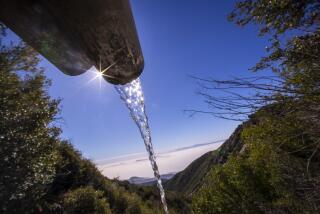Water Fight in the Mojave
A quarrel over waterholes in the Mojave is pitting hunters against naturalists, the needs of game animals against those of federally protected wildlife, and is resurrecting decade-old differences over the purpose of a national preserve.
Until recently, the dispute has been limited to mule deer and bighorn sheep hunters who favor the creation of more desert water sources and conservationists who argue that man-made waterholes draw predators that prey on the threatened California desert tortoise.
Now, a high-ranking official in the U.S. Department of the Interior has intervened on behalf of hunters and demanded the uncapping of 12 plugged wells, an action that would reverse a long-standing water policy in the 1.6-million-acre Mojave National Preserve. That, in turn, prompted a lawsuit this week by two environmental groups that say the order is illegal.
Ever since the preserve was created 11 years ago, the National Park Service, which manages it, has been working to buy out a handful of cattle ranches scattered through the preserve and cap wells that supplied water to livestock. Some of the buyout agreements, which were financed by the nonprofit National Park Foundation, called for the permanent capping of all ranch wells.
Earlier this year, Deputy Assistant Interior Secretary Paul Hoffman, a former aide to Vice President Dick Cheney, ordered the Park Service to allow the California Department of Fish and Game to reopen ranch wells and convert them to wildlife watering sites, known as guzzlers.
Hoffman issued the order over the written objections of Mojave Preserve Supt. Mary Martin.
The issue of man-made water supplies is especially important to hunters of mule deer, bighorn sheep, rabbits and quail. When the preserve was created in 1994, Congress directed that hunting be allowed.
However, in 2002 a group of 57 biologists, hydrologists and archeologists from around the country sent a letter to Hoffman asking for the removal of all guzzlers in the preserve.
The group said removal of artificial water sources was consistent with the principles of “conservation biology and park policy and law,” and with Park Service management policies that prohibit “artificial manipulation of habitat to increase numbers of a harvested species above its natural range in population levels.”
In addition, the scientists wrote that because of decades of groundwater pumping, 90% of the preserve’s natural springs and seeps had been adversely affected.
This week, the Center for Biological Diversity and Public Employees for Environmental Responsibility sued to prevent the first four wells from being uncapped and converted to water sites for wildlife. The lawsuit alleges that new guzzlers would be illegal, that well retrofitting requires environmental analysis, and that the watering devices have been shown to be harmful to other wildlife.
Hugh Vickery, an Interior Department spokesman, would not comment on ongoing litigation. Martin would not comment either.
Park Service hydrologists contend that the 30 or so ranch wells, some of which had been in operation for 100 years, siphoned water from a desert aquifer and compromised natural springs and seeps elsewhere in the Mojave.
Capping the wells, they say, has rejuvenated the preserve’s natural water sites, and removing cattle from the desert has promoted regrowth of native plants. Park Service officials say both outcomes have helped sustain wildlife, including deer and sheep.
Park Service biologists say there is no need for more water sources, pointing out that one population of mule deer has increased slightly every year since the ranch wells were shut down.
Separate from the ranch wells, the Mojave Preserve maintains about 133 guzzler water stations for small game and six for large game. Some are designed to trap rainfall and surface water into cisterns, and others pump groundwater into concrete-lined depressions.
Conservationists and biologists say guzzlers attract ravens that prey on the desert tortoise. Preserve officials say tortoise remains have been found in nearly one-third of the preserve’s guzzlers. Scientists surmise that tortoises either fall in and drown or are left in the water by predators.
Safari Club International, a hunting organization, and other groups have been pushing to reopen several wells. They met with Hoffman, Martin and representatives of the state Department of Fish and Game last August in Ontario.
Soon after the meeting, Fish and Game presented a plan to reopen 12 wells over three years. Martin balked, and a few months later Hoffman ordered her to allow Fish and Game to proceed with its plan.
State Fish and Game managers argue that wildlife in the preserve has become accustomed to the man-made water sources and that taking any water away would harm animals and ultimately reduce herd size.
“Our wildlife biologists who work out in the desert believe the water enhancement projects are necessary,” said Mike Haynie, a deputy regional manager for the department.
The project will cost about $40,000, according to the state agency. Its proposal says volunteers will build and maintain the pumps, pipelines and submerged tanks that support the guzzlers.
“It’s common sense,” said Pat Murch, a resident of Needles who said he has hunted in the Mojave all his life. “Our concern is that all of a sudden you go turn [wells] off and that’s going to affect the wildlife. We are simply asking the Park Service to use common sense.”
Under an agreement with the Department of Fish and Game, local hunting groups provide volunteers to maintain the water devices. However, a survey conducted by preserve staff last year found more than half of the guzzlers in a state of disrepair and 15% no longer functioning.
Ken Schwartz, a spokesman for Safari Club International, said that because roads are prohibited in much of the preserve, volunteers have difficulty getting to some guzzlers. But, according to the preserve’s survey, 93% of the guzzlers are within one mile of a road.
More to Read
Sign up for Essential California
The most important California stories and recommendations in your inbox every morning.
You may occasionally receive promotional content from the Los Angeles Times.











